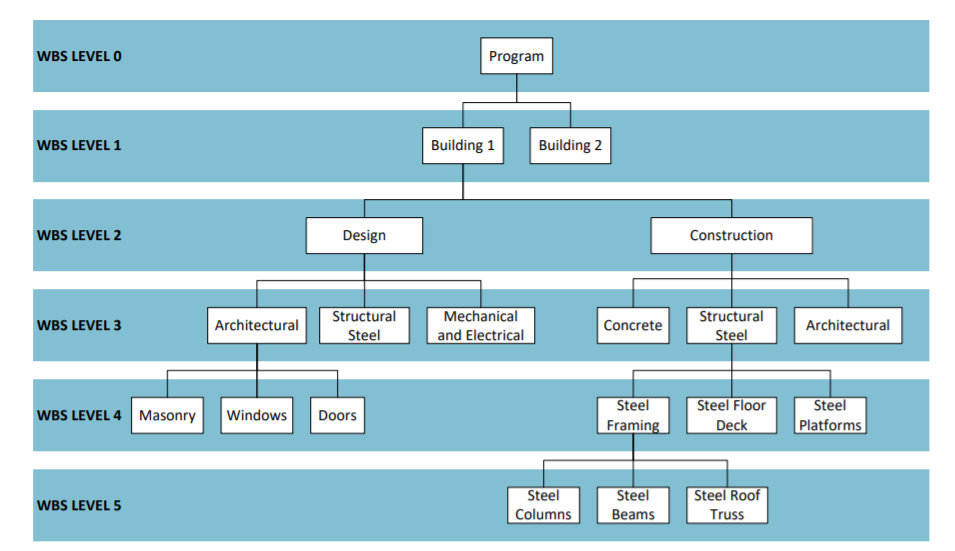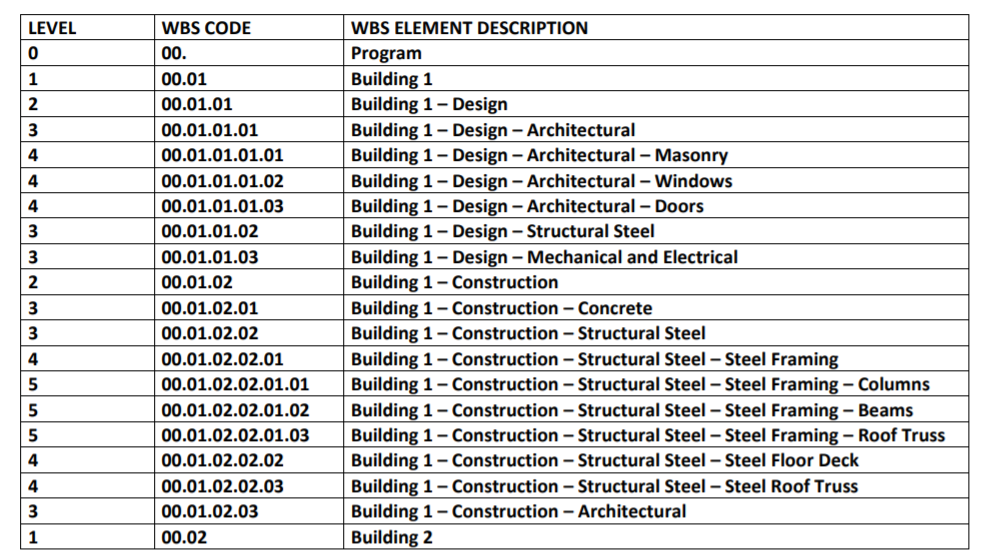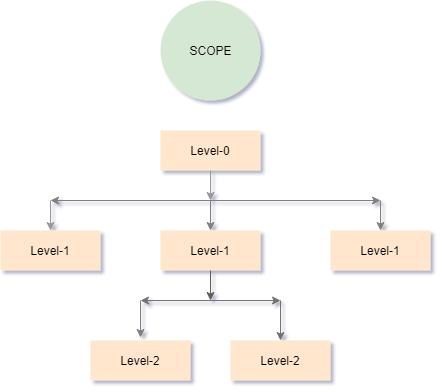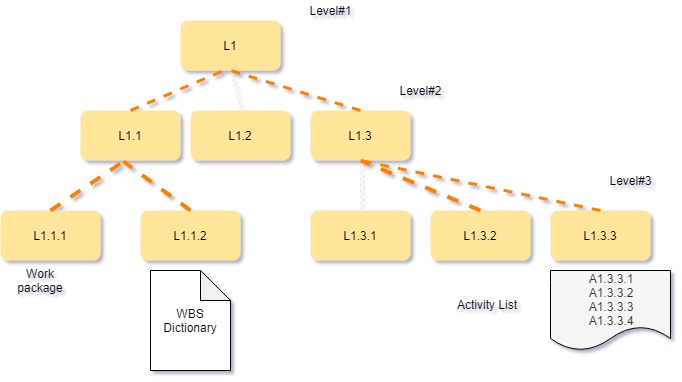Key points
- The Product Breakdown Structure (PBS) is super imposed with the actual work that need to be done to construct them to arrive at the Work Breakdown Structure (WBS)
- Once the WBS is defined and baselined, all further estimates will be based on it
- WBS comprises of various levels. As the levels increases the detailing increases
- The lowest level in a WBS are known as Work Packages
- Work packages are chunks of work which can be completed between 8 and 80 hours of work. This is known as 8-80 rule
- The entire scope of the project must be reflected in the WBS. This is known as 100 percent rule
- If something is missed out in the WBS, it will not be there in the final product
- Prior to schedule development, work packages are further decomposed into activities
Work Breakdown Structures are deliverable oriented grouping of work. A Work Breakdown Structure (WBS) is a hierarchical decomposition of the project scope into smaller, more manageable work packages. It organizes project work into hierarchical levels, making it easier to plan, manage, and track project activities. Work packages can be in the form of a tree or list.
WBS tree structure

WBS List structure

Here are examples of Work Breakdown Structures for both Engineering, Procurement, and Construction (EPC) projects and Information Technology (IT) projects:
Example 1: Work Breakdown Structure for an EPC Project (Hospital Project)
A Work Breakdown Structure (WBS) is a hierarchical decomposition of the scope of work into smaller, manageable components. For a hospital construction project, the WBS typically includes major phases, deliverables, and work packages that define the project’s objectives, schedule, and resources required.
Here’s an example of a high-level WBS for a hospital construction project:
1. Project Management
- 1.1 Project Planning and Coordination
- 1.1.1 Project initiation
- 1.1.2 Develop project plan
- 1.1.3 Resource planning and allocation
- 1.1.4 Stakeholder communication
- 1.2 Budget Management
- 1.2.1 Estimate costs
- 1.2.2 Monitor expenses
- 1.2.3 Financial reporting
- 1.3 Risk Management
- 1.3.1 Identify risks
- 1.3.2 Risk mitigation plan
- 1.3.3 Contingency planning
- 1.4 Quality Control
- 1.4.1 Develop quality standards
- 1.4.2 Inspection and testing
- 1.4.3 Deficiency tracking and resolution
2. Site Preparation
- 2.1 Site Survey and Analysis
- 2.1.1 Geotechnical study
- 2.1.2 Site survey
- 2.2 Site Clearing and Excavation
- 2.2.1 Tree removal
- 2.2.2 Soil excavation
- 2.2.3 Site grading
- 2.3 Temporary Facilities
- 2.3.1 Construction office setup
- 2.3.2 Worker amenities
- 2.4 Utility Setup
- 2.4.1 Temporary power supply
- 2.4.2 Water supply and sanitation
- 2.4.3 Communication lines setup
3. Foundation Work
- 3.1 Excavation and Shoring
- 3.1.1 Trenching
- 3.1.2 Soil stabilization
- 3.2 Concrete Foundation
- 3.2.1 Footings
- 3.2.2 Slab-on-grade
- 3.2.3 Foundation walls
- 3.3 Drainage and Waterproofing
- 3.3.1 Foundation waterproofing
- 3.3.2 Drainage system installation
4. Superstructure Construction
- 4.1 Structural Framework
- 4.1.1 Steel/Concrete frame
- 4.1.2 Floor beams and supports
- 4.2 Exterior Walls and Cladding
- 4.2.1 Brick or concrete walls
- 4.2.2 Insulation and exterior finish
- 4.3 Roof Structure
- 4.3.1 Roof framing
- 4.3.2 Roof sheathing and waterproofing
- 4.4 Windows and Doors
- 4.4.1 Window frames and glazing
- 4.4.2 External doors installation
5. Mechanical, Electrical, and Plumbing (MEP) Systems
- 5.1 Mechanical Systems
- 5.1.1 HVAC installation
- 5.1.2 Air handling units and ducts
- 5.1.3 Temperature control systems
- 5.2 Electrical Systems
- 5.2.1 Power distribution
- 5.2.2 Lighting and backup systems
- 5.2.3 Low-voltage systems (communication, security)
- 5.3 Plumbing and Sanitary Systems
- 5.3.1 Water supply and piping
- 5.3.2 Sewage and waste systems
- 5.3.3 Medical gas systems
6. Interior Works
- 6.1 Interior Walls and Partitions
- 6.1.1 Drywall installation
- 6.1.2 Acoustic partition walls
- 6.2 Flooring and Tiling
- 6.2.1 Floor leveling and preparation
- 6.2.2 Tile, vinyl, and carpet installation
- 6.3 Ceilings and Lighting
- 6.3.1 Ceiling installation (suspended, drywall)
- 6.3.2 Lighting fixtures and installation
- 6.4 Painting and Finishing
- 6.4.1 Wall painting and finishing
- 6.4.2 Trim and moldings
- 6.5 Furnishings and Fixtures
- 6.5.1 Hospital-specific furniture (beds, desks, etc.)
- 6.5.2 Medical equipment installations
7. Exterior Works and Landscaping
- 7.1 External Walkways and Roads
- 7.1.1 Concrete or asphalt roadways
- 7.1.2 Parking lot construction
- 7.1.3 Walkways and pedestrian paths
- 7.2 Landscaping
- 7.2.1 Lawn and greenery planting
- 7.2.2 Outdoor seating and recreational areas
- 7.3 External Lighting and Signage
- 7.3.1 External building signage
- 7.3.2 Parking and pathway lighting
8. Commissioning and Handover
- 8.1 Testing and Inspections
- 8.1.1 Structural integrity tests
- 8.1.2 MEP system testing and validation
- 8.2 Certification and Compliance
- 8.2.1 Building code certification
- 8.2.2 Fire safety inspection
- 8.3 Handover Documentation
- 8.3.1 As-built drawings
- 8.3.2 Operation and maintenance manuals
- 8.4 Final Handover to Client
- 8.4.1 Facility walk-through
- 8.4.2 Client training on operations
- 8.4.3 Final payment and closure
9. Post-Construction
- 9.1 Warranty and Support
- 9.1.1 Deficiency rectification
- 9.1.2 Warranty support for systems and equipment
- 9.2 Facility Operations
- 9.2.1 Ongoing maintenance plan
- 9.2.2 Emergency preparedness and safety drills
Breakdown Structure Considerations:
- Project Phases: Typically broken down into phases like planning, procurement, construction, commissioning, and handover.
- Location-Specific Requirements: Hospitals have specific needs, such as isolation units, operating rooms, infection control standards, and compliance with health regulations (which should be reflected in the WBS).
- Interdependencies: Ensure that dependencies between tasks (e.g., MEP systems installation before interior works) are identified.
This WBS can be further detailed depending on the size and complexity of the hospital project, including more granular levels of work packages. However, this structure provides a comprehensive framework to manage the project effectively.
Example 2: Work Breakdown Structure for an IT Project (Development of a Software Application)
- Project Management
- Project Planning and Coordination
- Stakeholder Management
- Risk Management
- Reporting and Documentation
- Requirements Gathering
- Stakeholder Interviews
- User Surveys
- Requirements Documentation
- Design
- Architecture Design
- User Interface Design
- Database Design
- Development
- Frontend Development
- Backend Development
- Database Development
- Testing
- Unit Testing
- Integration Testing
- System Testing
- User Acceptance Testing (UAT)
- Deployment
- Deployment Planning
- Installation and Configuration
- Data Migration
- Training and User Support
- User Training
- Documentation Development
- Help Desk Support
- Maintenance and Support
- Bug Fixes and Updates
- Performance Monitoring
- User Feedback and Improvement
In both examples, the Work Breakdown Structure breaks down the project scope into hierarchical levels, each representing a different aspect of the project. This hierarchical structure makes it easier to organize, plan, and manage project activities, ensuring that all necessary work is identified and accounted for.
100% rule
The 100% rule, also known as the “100% rule of allocation,” is a fundamental principle in Work Breakdown Structure (WBS) development. It states that the sum of the work at the lowest level of the WBS must equal 100% of the work represented by the higher-level parent element. In other words, the WBS should fully decompose the project scope, and every component of the project should be included in the WBS without any gaps or overlaps.
Here’s how the 100% rule works:
- Hierarchy: The WBS is organized hierarchically, with higher-level elements representing major deliverables or phases of the project and lower-level elements representing progressively detailed tasks or work packages.
- Decomposition: Each higher-level element in the WBS is decomposed into smaller, more manageable components at the lower levels. This decomposition continues until the project scope is fully defined and all work required to complete the project is represented.
- 100% Allocation: At each level of the WBS, the work represented by the child elements should collectively add up to 100% of the work represented by the parent element. This ensures that all project work is captured and accounted for within the WBS.
For example, consider a construction project to build a house. The top-level element of the WBS might be “House Construction.” This is decomposed into lower-level elements such as “Foundation,” “Frame Construction,” “Roofing,” “Interior Finishing,” and “Exterior Finishing.” Each of these elements should collectively account for 100% of the work required to complete the “House Construction” phase.
The 100% rule helps ensure that the WBS comprehensively represents the project scope and that no work is overlooked or duplicated. It provides a structured framework for project planning, scheduling, and resource allocation, enabling project managers to effectively manage and control project activities. Additionally, adherence to the 100% rule facilitates accurate cost estimation, progress tracking, and communication of project scope to stakeholders.


Work packages
The lowest level in a WBS is known as the Work package
A work package is a fundamental element of a project’s Work Breakdown Structure (WBS). It represents a discrete, manageable unit of work that contributes to the completion of a project deliverable or objective. Work packages are typically decomposed from higher-level project deliverables and further broken down into smaller tasks or activities that can be planned, executed, and tracked.
Here are key characteristics of a work package:
- Defined Scope: Each work package has a clearly defined scope of work, outlining the specific deliverables, objectives, and outcomes to be achieved.
- Measurable: Work packages are tangible and measurable units of work, with defined criteria for completion and success. They should be specific enough to allow for accurate estimation, planning, and monitoring of progress.
- Assignable: Work packages are assigned to individual team members or groups responsible for executing the work. Assignees are accountable for completing the work package within the specified constraints, such as budget, schedule, and quality standards.
- Time-Bound: Work packages have defined start and end dates, indicating when the work is expected to begin and be completed. Time-bound work packages help project managers track progress, identify delays, and manage project schedules effectively.
- Resource Requirements: Work packages outline the resources, such as personnel, equipment, materials, and budget, needed to accomplish the work. Clear resource requirements enable project managers to allocate resources efficiently and ensure that teams have the necessary support to complete the work.
- Dependencies: Work packages may have dependencies on other work packages, tasks, or project activities. Understanding dependencies helps project managers sequence work effectively, identify critical paths, and manage interdependencies to prevent bottlenecks and delays.
- Control Points: Work packages serve as control points for monitoring and managing project progress. Project managers track the status of work packages, assess performance against predefined metrics or milestones, and take corrective actions as needed to keep the project on track.
Work packages provide a structured framework for organizing, planning, and executing project work, enabling project teams to manage complex projects more effectively. By breaking down project deliverables into smaller, manageable components, work packages help streamline project management processes, improve resource allocation, and enhance overall project success.
litating effective planning, execution, and monitoring of projects in both EPC and IT domains
80-20 rule based Work package prioritization
80-20 rule is a globally applicable rule of thumb or hueristic which can be applied in various scenarios. For example;
- 80% of the wealth is with 20% of the people
- 80% of the population is in 20% of the countries
- 80% of the inventory cost is from 20% of the items
- 80% of the work is done by 20% of the people
- 80% of the defects are caused by 20% of the team members
The concept of the 80-20 rule can be applied to work packages within a project’s Work Breakdown Structure (WBS). In this context, the rule suggests that a minority of work packages (roughly 20%) often account for the majority of project effort or resources (about 80%). This principle emphasizes the importance of identifying and prioritizing the critical few work packages that contribute most significantly to project success.
Here’s how the 80:20 rule can be associated with work packages:
- Identification of Critical Work Packages: Project managers analyze the WBS to identify the critical few work packages that have the greatest impact on project objectives, timelines, and deliverables. These work packages typically involve complex tasks, high resource requirements, or significant dependencies with other project components.
- Resource Allocation: The 80-20 rule suggests that a significant portion of project resources and effort should be allocated to the critical few work packages that contribute most to project success. Project managers prioritize resource allocation, staffing, and budgeting to ensure that these work packages receive adequate attention and support.
- Risk Management: Work packages identified as critical according to the 80-20 rule are often associated with higher levels of risk due to their complexity, dependencies, or impact on project outcomes. Project managers focus risk management efforts on mitigating risks associated with these critical work packages to minimize potential disruptions or delays.
- Time Management: The critical few work packages identified through the 80-20 rule may also consume a significant portion of project time and effort. Project managers prioritize scheduling, task sequencing, and resource allocation to ensure timely completion of these critical work packages, thereby minimizing project delays and optimizing overall project schedules.
- Monitoring and Control: Project managers closely monitor progress and performance of the critical work packages throughout the project lifecycle. By focusing monitoring and control efforts on these key areas, project managers can quickly identify deviations, address issues, and take corrective actions to keep the project on track and mitigate potential risks.
Overall, the application of the 80-20 rule to work packages within a project’s WBS helps project managers prioritize resources, manage risks, optimize schedules, and enhance overall project performance by focusing efforts on the critical few work packages that drive project success.
8-80 rule based work package sizing
The concept of the 8-80 rule can also be applied to work package sizing within a project’s Work Breakdown Structure (WBS). In this context, the rule suggests that work packages should ideally be sized to be neither too small (less than 8 hours) nor too large (more than 80 hours).
Here’s how the 8-80 rule can be associated with work package sizing:
- Avoiding Micro-Tasks (Less Than 8 Hours): Work packages that are too small, typically less than 8 hours in duration, may not provide sufficient granularity for effective tracking and management. Micro-tasks can lead to excessive administrative overhead, increased complexity in scheduling, and difficulty in accurately estimating progress. Additionally, breaking down work into overly small tasks can hinder team productivity and motivation. Therefore, project managers aim to avoid excessively small work packages by consolidating tasks and grouping related activities.
- Preventing Macro-Tasks (More Than 80 Hours): Conversely, work packages that are too large, exceeding 80 hours in duration, may become unwieldy and difficult to manage. Macro-tasks can pose challenges in resource allocation, scheduling, and progress tracking. They may also increase the risk of delays and dependencies, as well as hinder the identification of potential issues and risks. To prevent overly large work packages, project managers decompose project deliverables into smaller, more manageable components, ensuring that work packages are sized appropriately for efficient execution and control.
By adhering to the 8-80 rule in work package sizing, project managers aim to achieve a balance between granularity and manageability. Work packages sized within the optimal range of 8 to 80 hours enable effective tracking, resource allocation, and progress monitoring, thereby enhancing project control and delivery efficiency. Additionally, appropriately sized work packages facilitate clearer communication, better task assignment, and improved team collaboration, contributing to overall project success.
100% rule
100% rule suggests that 100% of the scope must be covered in the Work Breakdown Structure (WBS). Once the WBS is finalised, all further planning will be based on the WBS, hence WBS must cover the entire scope of work of the project.
WBS dictionary
WBS dictionary provides additional information about the work packages so that the person who is really performing the work have sufficient information to do it right the first time without running around for clarifications.

